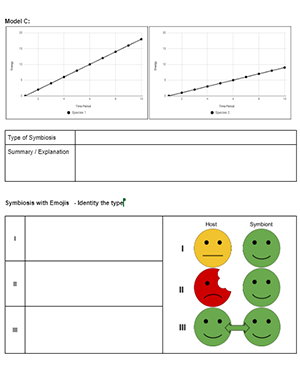
Students examine three graphs showing different types of symbiosis: mutualism, commensalism, and parasitism. For each graph, students identify the type of symbiosis and write a short summary about what is going on in each graph.
Example: Energy use in species one is increasing, energy use in species two is going decreasing. This indicates that one species is causing harm to the other. The type of symbiosis is parasitism.
The last graphic is a set of emojis depicting the different types of symbiosis. Students match the type of relationship to the smiling or frowning emojis.
The chapter on symbiosis also includes other species interactions and trophic cascades. You can access all the resources for Biology 1 at this page. This course is aligned to Miller and Levine Biology, Bee Book.
Students can practice their understanding of the different types of symbiosis with this Quizziz.
If you want to really spice up lessons on ecology and symbiosis, foster a hermit crab in your classroom. Hermit crabs use the discarded shells of snails as their home. This is a type of commensalism. The snails are not harmed (or benefitted), and the crabs do gain a benefit of shelter.
Another classroom example that is festive is mistletoe. Mistletoe is a plant parasite. They attach to a host and extract water and nutrients from the host plant.

